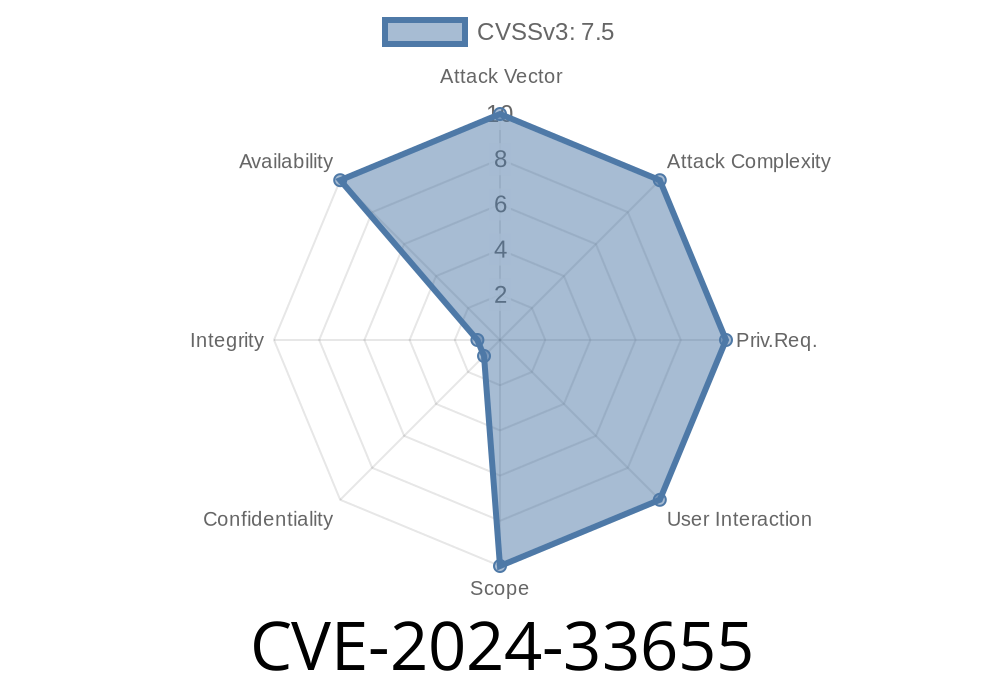CVE-2024-33655, known as the “DNSBomb” vulnerability, is a newly identified flaw in DNS protocol handling. This bug exploits core behaviors of DNS as defined in RFC 1035 and its updates. By carefully crafting and timing queries, attackers can accumulate DNS queries which are then released as a sudden, high-volume burst of responses. The result is resource exhaustion and denial of service (DoS) to clients and networks — and in certain cases, an amplification effect that greatly multiplies attack traffic.
In this post, we’ll break down what DNSBomb is, how it works with simple code and examples, and what you can do to defend your DNS ecosystem. We’ll use clear, direct language and include both technical details and mitigation tips for operators and developers.
Simple Version
The DNSBomb bug allows attackers to send a trickle of DNS queries, which a vulnerable server accumulates over a few seconds. Then, all the replies are sent at once in a burst (pulse). This overwhelms the network and client devices, creating a DoS and possibly amplifying attack traffic.
Why does it happen?
Some DNS server implementations delay answering rare or complex queries, often to avoid cache stampedes, rate-discoveries, or handling unavailable zones. An attacker can abuse these delays to stack up many queries and unleash them together.
References
- Original RFC 1035, defining DNS: https://datatracker.ietf.org/doc/html/rfc1035
- CVE Record for CVE-2024-33655: https://nvd.nist.gov/vuln/detail/CVE-2024-33655
- Publication introducing DNSBomb: https://www.usenix.org/conference/usenixsecurity24/presentation/sun-jinyang
Normal DNS Behavior
When you ask a DNS server to resolve a domain name, it either answers immediately (if cached) or fetches the answer from an upstream server. Sometimes, if lots of people ask for a not-cached or slow-to-resolve record, the server queues or rate-limits these requests.
The Exploit in a Nutshell
1. The attacker sends a bunch of DNS queries for names that are slow or expensive to resolve. But sends them just slow enough that the server queues them up instead of dropping them.
2. The server accumulates these queries, waiting to resolve them in a batch or to handle one upstream query that many clients are waiting for.
3. At a chosen time (after a few seconds), the server finishes the upstream query and blasts *all* the answers back to the waiting clients at once.
4. The effect is a burst of DNS traffic — far more than the original trickle that came in. If repeated, this can repeatedly spike a victim’s bandwidth and overwhelm the target.
Code Snippet Example: Exploiting DNSBomb
Suppose you want to show how a script might create this effect. Here’s a simple Python 3 example using dnspython that repeatedly asks for a random subdomain of a target DNS zone — enough to keep queries queued, but not so fast that the server notices a clear attack pattern. (NOTE: For research/defensive testing only, attacking production servers is illegal and unethical.)
import dns.resolver
import time
import random
import string
# Target DNS server and zone (use test server!)
resolver = dns.resolver.Resolver()
resolver.nameservers = ['1.2.3.4'] # Replace with test DNS server IP
def random_name(length=10):
return ''.join(random.choice(string.ascii_lowercase) for _ in range(length)) + '.example.com'
interval = .2 # Adjust for timing; too fast may trigger rate limits
count = 50 # Number of queries to stack up
for i in range(count):
name = random_name()
try:
print(f"Sending DNS query {i+1}: {name}")
resolver.query(name, 'A')
except Exception as e:
print(f"Exception for {name}: {e}")
time.sleep(interval) # Slow enough to keep accumulating
DNS Amplification: Why This is Dangerous
If those answers get broadcast out to many endpoints, or reflected back at a victim, this can act as a *traffic amplifier* — with the server multiplying the attacker’s original packets by a factor of 10x, 50x, or even more. Combined with source IP spoofing, the tears in internet infrastructure can open very wide.
The blast of DNS responses can saturate edge links, cause resolver outages, and degrade user experiences on a wide scale.
What Operators Can Do
- Upgrade DNS software: Check with your DNS vendor/distribution for patches or mitigations. Some have released advisories, for example BIND 9 mitigation tips.
- Limit queue time: Restrict how long a server holds queries in a pending state, or the maximum number it will batch for a single resolution.
- Rate limit “similar” queries: Don’t allow too many parallel requests for the same unknown domain from the same source network.
- Monitor burst traffic: Watch your DNS logs for bursts of outbound responses that don’t match inbound queries.
What Developers Can Do
- Defensive coding: Ensure DNS server software cannot stack up unlimited pending queries for one name or one upstream resolution.
Network Defenses
- Ingress filtering: Use BCP 38 to block spoofed traffic.
- Monitor unusual DNS spikes: Use flow monitoring or DNS-specific analytics to spot sudden unexplained reply spikes.
Conclusion
CVE-2024-33655 (“DNSBomb”) exposes a fundamental risk in how DNS queues slow queries. Attackers can carefully time requests to stack up, then unleash a traffic pulse, resulting in denial of service or even amplification that far exceeds the original trickle of packets. With simple scripts and a basic understanding of DNS caching and pending-lookup logic, this bug has real-world consequences for internet stability.
Check your DNS software, watch your logs, and stay updated with security advisories. For further reading and complete research, see:
- USENIX Security ‘24: DNSBomb Paper
- RFC 1035: Domain Implementation and Specification
- BIND Advisory: CVE-2024-33655
Are your DNS servers prepared for the next “bomb”?
Disclaimer: This post is for educational and defensive use only. Never attack production or third-party servers.
*Stay safe, stay patched!*
Timeline
Published on: 06/06/2024 17:15:51 UTC
Last modified on: 08/22/2024 19:35:27 UTC
